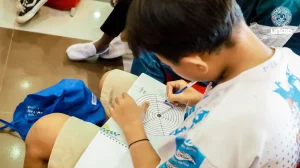The demographic bonus that occurred in Indonesia caused an increase in the elderly population. On the other hand, increasing the prevalence of type 2 diabetes mellitus (abbreviated as diabetes). The elderly population in Indonesia is predicted to reach 36 million by 2025. The prevalence of diabetes itself has increased from 1.1 % to 2.3 % percent in 5 years, 50 % of which are elderly and increase the risk of premature death by up to 5 times, death due to complications of the disease heart 4-times even 20-times greater risk of death due to complications of kidney disease.
The main risk factor for diabetes is known to be obesity so that in older adults with diabetes, maintaining body mass index status is important for controlling blood sugar. The research that focuses on behavioural aspects to do physical activity and overcome obstacles and behaviour patterns while related to the body mass index of older people with diabetes.
The study was conducted in the working area of Jagir Health Center, Surabaya City. Elderly who are still able to carry out daily activities are included as criteria.
Self-efficacy or self-confidence to carry out physical activities and overcome obstacles is assessed using a structured questionnaire with a Likert scale of 10-100. The more confident the older adult in overcoming obstacles, the higher the value is given. Out of 56 respondents, 71.4% were women; 46.4% of elementary school graduates; 82.2% are retired, with an average age of 66.8 years and number of children 3.
Nutritional status of diabetic elderly based on body mass index, amounting to 15% of overweight elderly and 56% obese. This prevalence supports the initial hypothesis that obesity is a major factor in diabetes.
It can be motivated by the accumulation of fat tissue, especially in the abdomen and increased adipokin production. The full explanation is stated in the publication text. The further result is the level of physical activity of the elderly related to body mass index.
At least 89% of the elderly have a level of physical activity in the mild category. It might be related to the number of elderly who are overweight and obese, making it more difficult to move. Older people with diabetes who are not physically active have a higher risk of death from cardiovascular disease. Besides, physical inactivity is associated with poorer blood sugar control.
The low physical activity of older people with diabetes is also associated with a sedentary activity. The activities are mostly done by sitting, such as chatting, watching TV, playing cellphones, etc. 59% older people spent> 3 hours/day.
The activity also significantly increases the body mass index. Based on other studies mentioned that a decrease in sedentary activity by <3 hours/day can increase life expectancy up to 2 years. Judging from the elf-efficacy or the level of confidence, the average value of the elderly sure to be able to do physical activity is quite good (59.13), while the to overcome obstacles is 52.5. It shows that older people are more convinced to exercise physically.
Another interesting obstacle concluded from this research is physical activity. First, the elderly feel uncomfortable doing physical activity, and some older people have just recovered from health problems, feeling anxious, so they do not have time to do physical activity and personal problems. With this research, interventions can be carried out by focusing on eliminating the obstacles felt by the elderly. Thus, they can easily do physical activities every day or at least 3-5 times per week.
Author: Qonita Rachmah, S.Gz., M.Sc (Nutrition & Diet)
Detail information from this study can be seen in our article in the Journal of Preventive Medicine & Public Health
https://www.jpmph.org/journal/view.php?doi=10.3961/jpmph.19.003
Rachmah, Q., Setyaningtyas, S. W., Rifqi, M. A., Indriani, D., Nindya, T. S., Megatsari, H., … & Kriengsinyos, W. (2019). Self-efficacy to Engage in Physical Activity and Overcome Barriers, Sedentary Behavior, and Their Relation to Body Mass Index Among Elderly Indonesians With Diabetes. J Prev Med Public Health, 52, 242-249. DOI: https://doi.org/10.3961/jpmph.19.003









